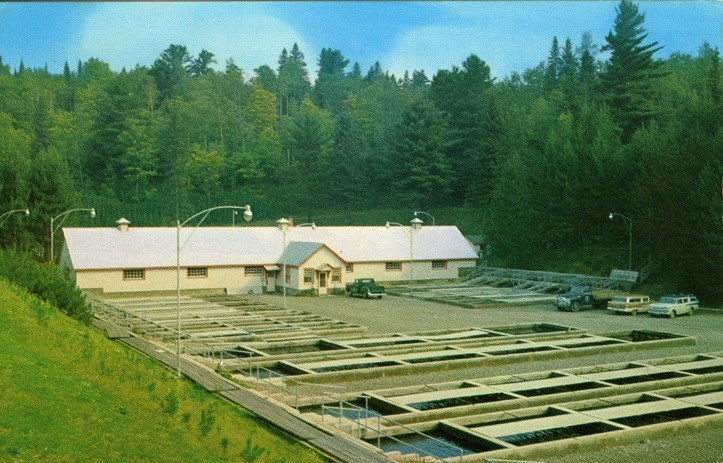From the archives of the Sault Ste. Marie Public Library:
People in Sault Ste. Marie had been requesting a fish hatchery since the early 1890s. W.J. Thompson, a member of the Town Council for 1890-1891, was a strong advocate along with Dr. W.A. Adams, owner of Adams Drug Store.
During this time, the local streams and lakes were beginning to show signs of depletion and they felt that a fish hatchery was needed to be able to restock the local waterways. However, it took another thirty years for the Provincial Department of Game & Fisheries to begin construction of a fish hatchery, in January of 1921.
It was expected to be one of the best fish hatcheries in the Dominion of Canada and was to eclipse that of the hatchery that was located in Sault, Michigan at the time. The building permit for the hatchery was estimated for $20,000 and in 1920 $10,000 was earmarked for erecting ponds, buildings, equipment and for propagation of fish. Due to the cold northern climate, the construction proceeded slowly with frozen ground and the rocky terrain delaying the process, however by February they had finished the excavation work.
Elsewhere in the province during the early 1930s, fish were successfully raised but the methods for introduction into waterways were often questioned. There were cases reported that fry — an early stage of fish development — were released into the waterways with no chance for their survival. Some were dumped into ice-cold streams, and in one case, stories were told about cans of fry being taken up the ACR and when the river banks were found to be too steep, those given the job of releasing the fish went out onto a railway trestle and dumped the fry over the side of the trestle. These fish would have had no chance of surviving. These practices cost the provincial department thousands of dollars.
However, the local Fish Hatchery for Algoma had abandoned these practices long before the rest of the province. They did not release fry but waited for the fish to reach the fingerling stage in their development. When it came time to release them, they took steps to ensure that the temperature inside the cans was the same as the temperature of the waterway before the fish were released.
The original fish hatchery was replaced by a newer facility in the 1950s to increase their ability to raise fish in a more modern facility. This new hatchery featured outdoor cement ponds. The new hatchery was able to provide 600,000 fish each year.
In the mid-1980s the Ministry of Natural Resources spent $7.4 million to replace the Tarentorous Fish Hatchery. The outdoor cement ponds were replaced with indoor pools and a larger space creating a more controlled environment for raising fish. By 1988, the new Tarentorous Fish Hatchery was expected to double lake and brook trout production so that they would be able to produce 1.6 million stockable fish. When it was completed it was the one of the largest and most modern facilities in the province.
One of the main jobs of the fish hatchery is to maintain a controlled environment in order to raise fish eggs to maturity. Each egg is bathed in an iodine solution to kill any bacteria. However, in 1994 a deadly bacteria, which is found in baby brook trout swept through the hatchery. The disease killed more than 3,000 fish.
This disease outbreak resulted in the Ministry of Natural Resources destroying 180,000 brook trout. The staff members have also had to guard against other predators. In one instance mink tracks were spotted approaching the door of the hatchery on a regular basis during one winter. Fortunately this mink could not gain entry into the facility and was unable to have the “feast” that he was hoping for.
The work of a fish hatchery is important to local anglers as well as being a benefit to the tourism industry. Many visitors come to the area in order to fish in our local lakes and rivers and we can be thankful for the wonderful work that our Fish Hatchery has done over the past century.
Each week, the Sault Ste. Marie Public Library and its Archives provides SooToday readers with a glimpse of the city’s past.
Find out more of what the Public Library has to offer at www.ssmpl.ca and look for more Remember This? columns here
